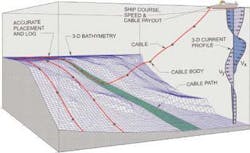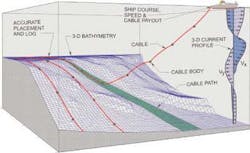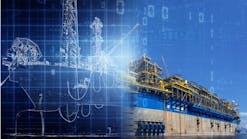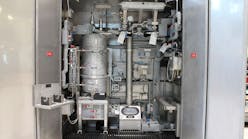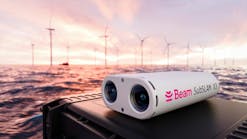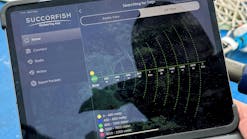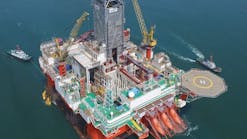EQUIPMENT & ENGINEERING: Mapping seismic cable shape, touchdown, retrieval with software
MakaiLayTM is a new Windows-operated, PC-based software system that can be used as a cable lay and retrieval system for the seismic industry. The software reportedly provides real-time feedback, monitoring, and control of cable shape and touchdown conditions during cable operations. Features claimed for the software include:
- Real-time 3D dynamic modeling of the cable in suspension to provide accurate cable and sensor positioning.
- Accurate predictive modeling of a cable operation by running another instance of the 3D dynamic model hours into the future.
- Real-time modeling of cable retrieval that can be used to form cable shapes that significantly reduce cable tensions, bottom dragging, and the risk of damaging the cable.
- The ability to pre-plan and train for cable operations by performing in-house simulations.
Cable control and positioning becomes more difficult with increasing water depth and is primarily dependent upon response time. If the response time between performing a ship maneuver and seeing the reaction of the cable on the seafloor were zero, then cable control would be elementary. The reality is that cable response time can far exceed one hour, depending on the conditions of the cable lay. This means that attempting to control the touchdown position using data received in real-time is a non-productive effort.
By utilizing the "faster than real time" power of the 3D dynamic model, one can model the cable installation well into the future in order to determine an optimum set of instructions to guide the ship and cable payout. The instruction set can be continuously modified as the lay proceeds ensuring high placement accuracy and the ability to respond to changing conditions as the lay progresses.
The program's control capabilities are claimed to allow faster and safer installation and retrieval of seismic cable arrays. The advanced control capabilities will allow installers to accurately lay a complex seismic array in the shortest time possible with all sensors as close as possible to the desired target positions.
Cable recovery is enhanced as both the speed and safety of the retrieval operation improves. During the lay process, the software produces a log of the as-laid cable position. During recovery, the control system can then accurately guide the cable recovery along the logged position and lift the cable cleanly from the seabed, minimizing the amount of seabed cable movement thus reducing possible cable breakage and enhancing the expected life span of the cable.
The software is also a cable planning tool and is able to run in-house simulations while the cable operation is still in the planning stages. The simulations can be detailed and designed to include estimates of model input errors (from sensors, oceanographic data, or cable properties) that can be expected during the actual cable lay operation to determine the best cable placement accuracy that can be achieved. Some of the more critical model inputs include cable diameter, drag coefficient, cable weight, cable length, bathymetry, ocean currents, ship position, ship speed, cable payout speed, and ship heading.
Taking this a step further, these inputs can be used to compose a detailed sensitivity analysis for a specific situation. Makai has performed sensitivity analyses related to the placement of seismic (2C/4C) sensors on the ocean floor. The results for these analyses were used to determine suitable cable designs and methods of installation. The results can also be used to determine the trade-offs between installation speed, placement accuracy, and the costs as related to the equipment and techniques used in the cable lay process.
Contingency situations
Beyond just simulating a successful cable lay, MakaiLay can be used to simulate particular contingency situations (unplanned emergency situations that occur due to equipment failures or unexpected lay conditions) and to develop standard operating procedures for when these occur in real life. This not only reduces the risks associated with an operation, but also is an invaluable training tool for those in charge of the cable operation.
The model is said to be accurate, and lay results are primarily dependent on equipment accuracy. In favorable conditions, the model has a placement accuracy of within 1-3% of the water depth. With high installation speed (5 kt), no current measurement and very light cables, the placement accuracy can exceed 20% of the water depth. Knowing this information early in a project's development can go a long way towards developing hardware and procedures for optimizing placement accuracy.
Reference
Andres, J.; Jeffries, S.; Gillenwaters, G.; Validation of a Real-Time Cable Deployment Control System For Slack Cable Laying, Proc. Oceans '93 Conference, Victoria, British Columbia, Canada, 1993.
